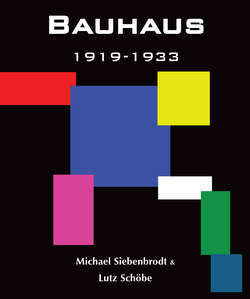Читать книгу Bauhaus. 1919-1933 - Michael Siebenbrodt - Страница 10
На сайте Литреса книга снята с продажи.
History of the Bauhaus
On the Way to [Becoming] the Modern Academy of Design: The 1921–1922 Formation Phase
ОглавлениеIn 1922, Walter Gropius reorganised the Bauhaus Masters’ duties. In particular, Johannes Itten’s many duties and power were reduced; following Klee and Schlemmer, Moholy-Nagy took over the metal workshop in 1923, Klee took over the stained glass painting workshop, Kandinsky, after an interlude by Schlemmer, took over the mural-painting workshop, Muche the weaving and Gropius himself the furniture workshop. At the same time, the Masters’ Council, the Bauhaus’s highest leadership body, discussed intensely the idea and structure of the Bauhaus. Klee provided a sketch showing the Bauhaus as a globe with a sun motif in the centre. The earth’s axis bore two triangular pennants reading “propaganda” and “publisher” and referred to the Bauhaus Masters’ media strategies, which decisively influenced the corporate identity and international aura of the Bauhaus with their Bauhaus print portfolios, Bauhaus books, the Bauhaus magazine, and with exhibitions and lectures.
The globe’s outer ring listed the preliminary lessons, the preparatory course, as an important pedagogical invention for the preparation for regular studies in the Bauhaus workshops, which were described with material terms such as wood, stone, metal, etc. in the sun’s rays. The workshop work was linked in this sketch to the artistic and natural science technical courses, such as nature studies, colour and composition theory, construction theory, material studies or material and tool theory. The representation of the sun was in the centre with the terms “construction and theatre,” and referred to the unity of the arts and at the same time the promotion of all creative talents in the students. The official diagram of the course of studies dispensed with the symbols of sun and earth and with the central positioning of theatre, but on the other hand emphasised in its strict circular shape the seriousness of the three-level education, the one-semester preparatory course, the three-year manual trades training with the Journeyman exam and the practical training in construction in postgraduate studies.
Oskar Schlemmer, Seal of the Weimar Bauhaus, “Profile”, 1922
© Oskar Schlemmer Archive and Theatre Estate
Gropius was only able to implement regular architectural education with the appointment of Swiss national Hannes Meyer (1889–1954) to the Dessau Bauhaus in 1927. This change in the perception of the Bauhaus was also to be reflected in a new signet, which was designed by means of a competition between the Bauhaus Masters. Oskar Schlemmer’s head in profile emerged as the winner. Again, man was in the centre, now reduced to the head as the centre of feeling and intellect in a geometrically abstract use of form typical of the industrial age. The Bauhaus’s reorientation was substantially stimulated by the work of Theo van Doesburg (1883–1931) in Weimar. In 1917 Doesburg had founded the Dutch artists’ association De Stijl with Piet Mondrian (1872–1944), which with its holistic approach deduced a canon of artistic means with right angles and primary colours complemented by grey, black and white – a modern style. In December van Doesburg had visited the Bauhaus, and he had moved to Weimar in 1921. From March to July 1922, he held his legendary De Stijl class in Karl Peter Röhl’s studio in Weimar. More than twenty people participated, mainly Bauhaus students, from Walter Herzger (1903–1985) to Andor Weininger (1899–1986), but also some teaching staff: Josef Zachmann (born 1905), Erich Brendel and fellow artists from Jena like Max Burchartz (1887–1961) and Walter Dexel (1890–1973). On 25th September 1922, Theo van Doesburg also called the Congress of Constructivist International to Weimar, and was hoping to follow Itten into the Master’s position he was going to vacate, but Gropius appointed Hungarian constructivist and concept artist László Moholy-Nagy (1895–1946) instead. Thus Gropius consciously avoided the dominance of any one style at the Bauhaus in favour of an open and pluralistic design concept, which was oriented not least on the new opportunities of print media and advertising, film, photo and electronic data transmission. The KURI group (Constructive-Utilitarian-Rational International) of Bauhaus students, led by Farkas Molnár (1895–1945), which had been formed at the end of 1922, also promoted the modernisation of the Bauhaus.
This period also includes the only larger municipal architectural project, the reconstruction of the Jena City Theatre in 1921/22, commissioned by Ernst Hardt, the Director of the German National Theatre in Weimar. In the course of this renovation, a fresco by Schlemmer was washed off the ceiling in the auditorium due to complaints by Dexel and van Doesburg, who replaced it with a painting in grey, peach and deep blue.
On 13th April 1922, the Bauhaus development co-operative was founded to overcome the lack of student and teacher studios and living spaces, but also to promote the construction of a new academy building with better workshop facilities. In June 1922 the Thuringian state government requested a comprehensive exhibition of the Bauhaus achievements and made the further allocation of funds dependent on it. Gropius scheduled this exhibition for the summer of 1923 and focused the forces of the entire school on this goal, which is why no new students were accepted at the Bauhaus at that time. The first Bauhaus art exhibition took place at the end of 1922 in Calcutta, India, initiated by the Indian poet and painter Rabindranath Tagore (1861–1941). More than 250 hand drawings and printed graphics by the Bauhaus Masters, among them theatre projects by Schreyer and numerous preparatory course works by Margit Téry, were presented.[3]
Paul Klee, Idea and structure of the Bauhaus, 1922
Walter Gropius, Model of studies at the Bauhaus, 1922
3
Main Archive of the Free State of Thuringia, Weimar, File Bauhaus 57, pp.2–75.
